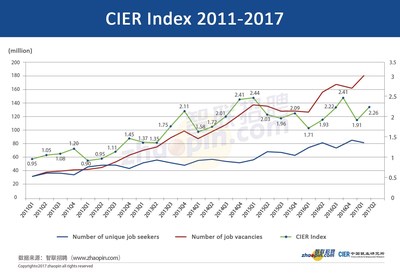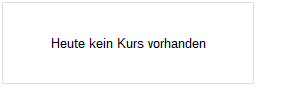
China Labor Market Continued to Improve in the Second Quarter of 2017
PR Newswire
BEIJING, July 20, 2017
BEIJING, July 20, 2017 /PRNewswire/ -- Zhaopin Limited (NYSE: ZPIN) ("Zhaopin" or the "Company"), a leading career platform[1] in China focused on connecting users with relevant job opportunities throughout their career lifecycle, and the China Institute for Employment Research ("CIER") at Renmin University released the CIER Employment Index Report for the second quarter of 2017.
As the overall economy grew steadily in the second quarter of 2017, the labor market in China became more favorable for job seekers with increasing labor demand, and a decline in job applicants.
China's Second-Quarter 2017 Labor Market Highlights:
- The CIER index in the second quarter of 2017 rose to 2.26, from 1.93 during the same period of 2016 and 1.91 in the first quarter of 2017. The labor market improved in the second quarter with increasing labor demand, and a decline in job seekers.
- Internet and e-commerce continued to be the best-performing sector, while printing/packaging/papermaking was the worst.
- Eastern China continued to enjoy the highest CIER index score of 2.03, followed by 1.76 for Central China and 1.67 for Western China.
- The CIER index for micro-sized companies declined by 0.4 in the second quarter of 2017 year-over-year. With declining investment this year, some start-ups were struggling to survive.
- The CIER index is very likely to increase significantly in the third quarter of 2017 due to strong seasonal factors.
Methodology and how to interpret the data
Based on data from Zhaopin's online recruitment platform, the CIER index tracks the ratio changes between job vacancies and job seekers in a variety of industries and cities across the country, and identifies the overall trend in China's employment market. Jointly published by Zhaopin and the CIER at Renmin University every quarter, the CIER index has become a leading barometer of China's labor market and macro-economic environment.
The CIER index score is calculated by dividing the number of job vacancies during a specified period by the number of unique job seekers during the same period. A CIER index score of more than 1 indicates that the labor market is booming, with more vacancies than job seekers. A CIER index score of less than 1 indicates that the labor market competition is intensifying, with more job seekers than available vacancies.
CIER index rising with growing economy
In the second quarter of 2017, the economy in China continued to grow with the GDP increasing by 6.9% year-over-year. The CIER index for the labor market rose to 2.26 in the second quarter of 2017, up from 1.93 during the same period of 2016 and 1.91 in the first quarter of 2017. The rising CIER index was caused by increasing labor demand, and a decline in job seekers in the second quarter.
The improving economy had created more job demand in the second quarter this year, especially in the booming new economy driven by internet and e-commerce. After the peak season for job hopping in the first quarter, many job seekers already found new jobs, which led to the decline in job applicants in the second quarter of 2017. The rising CIER index indicated that the labor market in China became more favorable for job seekers.
While the combination of stronger labor demand and fewer applicants may mean more opportunities for those on the hunt for a job, it's not translating into higher pay at the moment. On July 17, 2017, Zhaopin reported that the average monthly salary for white-collar workers was RMB7,376, in the second quarter of 2017, down by 3.8% over the first quarter, based on online job postings in 37 key cities in China. This was the first time that the average monthly salary declined quarter-over-quarter since the second quarter of 2015. The falling average salary for white-collar workers was mainly caused by a 31% decrease in average salaries at micro-sized companies. With investment waning, many small start-ups became more rational and could no longer offer higher salaries to attract talents. An additional factor contributing to the overall decline in salaries in the second quarter of 2017 was that more jobs were located in lower-tier cities, where pay is normally lower.
In addition, while online recruitment demand continued to gain, the pace of growth is slowing. According to Zhaopin's data, total online recruitment demand in China rose 36% year-over-year in the second quarter of 2017, compared with a 52% year-over-year growth in the first quarter of 2017.

CIER index by sectors
The internet/e-commerce sector continued to be the best-performing sector in the second quarter of 2017, with recruitment demand far exceeding the number of job seekers. The real estate/construction/building materials/engineering sector was also booming in lower-tier cities, pushing the CIER index for the sector to 3.83 in the second quarter of 2017, from 2.78 in the first quarter this year.
| Ten best-performing sectors in the second quarter of 2017 | ||
| Ranking | Sector | CIER index |
| 1 | Internet/e-commerce | 9.06 |
| 2 | Traffic/transportation | 7.64 |
| 3 | Insurance | 5.85 |
| 4 | Intermediary service | 5.74 |
| 5 | Funds/securities/futures/investment | 5.26 |
| 6 | Logistics/warehousing | 4.10 |
| 7 | Real estate/construction/building materials/engineering | 3.83 |
| 8 | Farming/forestry/animal husbandry/fishery | 3.78 |
| 9 | Education/training/college | 3.64 |
| 10 | Computer software | 3.57 |
The gap between the best-performing sectors and the worst-performing sectors actually narrowed in the second quarter of 2017 as the restructuring of the economy began to show some results. The CIER index of the energy/mineral/mining/smelting sector rose to 0.60 in the second quarter of 2017 from 0.32 in the first quarter this year.
| Ten worst-performing sectors in the second quarter of 2017 | ||
| Ranking | Sector | CIER index |
| 1 | Printing/packaging/papermaking | 0.35 |
| 2 | Petroleum/petrochemical/chemical | 0.52 |
| 3 | Environmental protection | 0.54 |
| 4 | Energy/mineral/mining/smelting | 0.60 |
| 5 | Instruments/apparatuses/industrial automation | 0.65 |
| 6 | Property management/business center | 0.71 |
| 7 | Inspection/testing/authentication | 0.75 |
| 8 | Aerospace research and manufacturing | 0.78 |
| 9 | Electricity/power/water conservancy | 0.82 |
| 10 | Office supplies and equipment | 0.86 |
The traffic/transportation sector enjoyed the highest increase in job demand among all sectors, with 55% growth in the second quarter of 2017 year-over-year, as the government gave priority to the sector and invested heavily to build transportation infrastructure across the country.
| Year-over-year change in recruitment demand for | |
| Nationwide | 55% |
| First-tier cities | 30% |
| Emerging first-tier cities | 81% |
| Second-tier cities | 86% |
| Third-tier cities | 64% |
The IT and internet sector saw growth in job demand slow in the second quarter of 2017. The job demand from this sector increased by 36% year-over-year in the second quarter of 2017, compared with a 56% growth year-over-year in the first quarter this year. As investors became more rational, many start-ups in the sector could no longer "burn money" for fast expansion.
| Year-over-year change in recruitment demand for | |
| Nationwide Werbung Mehr Nachrichten zur Zhaopin ADR Aktie kostenlos abonnieren
E-Mail-Adresse
Bitte überprüfe deine die E-Mail-Adresse.
Benachrichtigungen von ARIVA.DE (Mit der Bestellung akzeptierst du die Datenschutzhinweise) -1  Vielen Dank, dass du dich für unseren Newsletter angemeldet hast. Du erhältst in Kürze eine E-Mail mit einem Aktivierungslink. Hinweis: ARIVA.DE veröffentlicht in dieser Rubrik Analysen, Kolumnen und Nachrichten aus verschiedenen Quellen. Die ARIVA.DE AG ist nicht verantwortlich für Inhalte, die erkennbar von Dritten in den „News“-Bereich dieser Webseite eingestellt worden sind, und macht sich diese nicht zu Eigen. Diese Inhalte sind insbesondere durch eine entsprechende „von“-Kennzeichnung unterhalb der Artikelüberschrift und/oder durch den Link „Um den vollständigen Artikel zu lesen, klicken Sie bitte hier.“ erkennbar; verantwortlich für diese Inhalte ist allein der genannte Dritte. Andere Nutzer interessierten sich auch für folgende News | |


